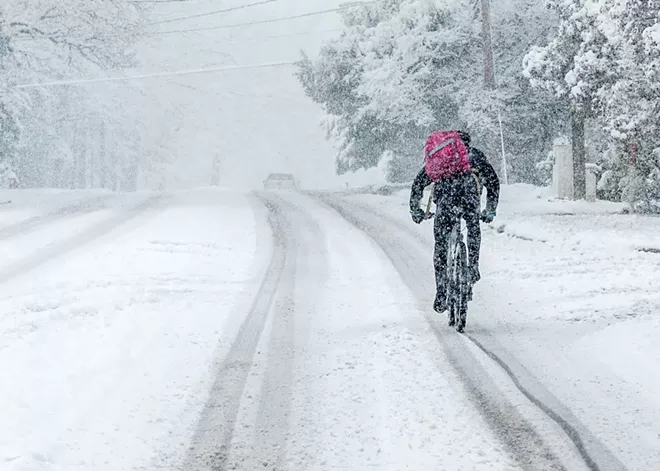Every year, the same dread. The sun will go down before I get off work. The temperature will barely break freezing for weeks on end. The dormant season has begun.
Last year, for the first time in my 15 years living in the Inland Northwest, I made the decision to not let it get to me. I wouldn’t let meaningless things like the tilt of the Earth and eternal change of the seasons affect my behavior. No, I would carry on.
So I put studded tires on my bicycle.
Why did I wait so long? For starters, I’m the type of person who doesn’t want to change clothes simply to commute to work or go to the grocery store. No Lycra, no clipless pedals, no cycling arm warmers. I do, however, wear a helmet. That’s about as particular as I get because the bike works for me, not the other way around. Putting special tires on seemed to defeat the purpose of my go-anywhere, anytime bike.
And it wasn’t like I didn’t already ride most of the year — unlike what some haters and naysayers claim is impossible in this wintry place. Most years, I can ride in every month but January, when instead I walk to work and enjoy the silence.
So, about a year ago, I put on the studs. My first ride was frightful. The compacted snow left behind by all those cars was the worst. The studs got no bite, and I fishtailed around, waiting to be tossed into the berm and covered up, only to be discovered in the spring along with all the dog poop people think miraculously disappears when their pups go in snow.
But I made it, and kept going. When I hit ice, it was a miracle. I could hear my little steel studs chewing away and it was like the normal times, before the sun absconded to the southern hemisphere, leaving us Donner Partiers behind. I pedaled all the way down the South Hill, and got on the Centennial Trail. I turned west, untouched frozen splendor lay before me, and blazed a trail through newly fallen snow. The soft crunch of packing snow was all I heard. I felt like an astronaut, or some sort of Arctic navigator, heading to parts unknown by way of my own wits (and an industrially produced bike from Taiwan).
That joy stuck with me all winter. I avoided the worst of winter depression by embracing winter and engaging with the cold on my terms. I kept riding the Centennial Trail and commuting to our Kendall Yards office. I even braved the Fish Lake Trail, but turned back early when I hit footsteps locked in their frozen molds — perhaps the worst riding surface I’ve ever encountered.
On my favorite winter rides, I’d be quietly zipping through the sleeping forests of Riverside State Park, Ben Burr Trail and more. I’d tell myself I was taking a bath, or shinrin-yoku. This practice of “forest bathing” began in Japan, but has taken root all over the world. It’s simple. Basically, get out into the woods for a while and move around.
Some studies have shown that it decreases stress and blood pressure, makes your heart healthier, and lowers cortisol levels, and even boosts your mood. It might have something to do with just being somewhere peaceful while your body is moving, or it could have something to do with the chemicals emitted from trees — phytoncides — and how they might enhance our immune systems.
I don’t know. But I think it works. Plus, I like to tell people I’ve taken a bath in the snow while riding a bike. Which makes me smile, and that’s all I’m looking for sometimes during these Spokane winters.
Last week, I was again on the Centennial Trail. The pavement was dry, and I’d planned to turn back at Seven Mile. Instead, I kept going all the way to Long Lake before turning back. I made it home, tired and sweaty, after that three-hour bath. I couldn’t have been happier. ♦
